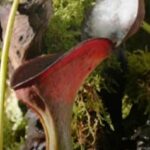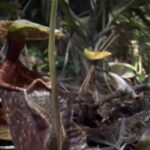As an Amazon Associate, this site earns commissions from qualifying purchases. For more details, click here.
Found along marshes, bogs and swamps, pitcher plants have also made their way to homes as people continue to be fascinated by them. Pitcher plants feed on insects for nutrition, but do they also consume bees? What happens if they do? If you do not often hear bees being eaten by nepenthes. there is a good reason for it.
Pitcher plants try to avoid eating bees because they are pollinators. These plants have several mechanisms that can differentiate between pollinator and prey, but if a bee accidentally falls into a pitcher, it will be eaten.
Why Pitcher Plants Avoid Eating Bees
Because pitcher plants grow in nutrition deprived soil, they eat insects to get nutrients. But all carnivorous plants try not to eat bees because they pollinate their flowers.
While pitcher plants are different from non-carnivorous ones, they do share the need for pollination. Bees play a major role in the ecosystem, and these plants have taken steps to protect them from their traps.
Pitcher plants propagate in several ways but pollination is a crucial part of their reproduction. It is vital not just to carnivorous plants but all plants, fruits and vegetables. But first, we need to understand how pollination works and how both bees and pitcher plants benefit. Once you understand why, it will be clear why pitcher plants have developed means to avoid eating bees as much as possible.
How Bees Pollinate Pitcher Plants
When a bee lands on a nepenthes flower for instance, it extracts nectar. Honey is derived from nectar so bees take this from the plant and place it in their stomach. Bees have two stomachs, one for eating food and the other to store nectar so it can be taken to their hive.
Once a bee starts gathering pollen and nectar, pollen from the male part of the flower gets stuck onto its body. When the bee moves to another flower, the pollen falls into the female part. After the bee drops onto a flower, they end up with pollen sacs on their feet. When the bee flies and lands on another flower, it drops the sac and the pollen falls.
This process is repeated by other bees on other plants. Here you can see why this is mutually beneficial to both and why pitcher plants avoid eating them.
How Pitcher Plants Distinguish between Pollinator and Prey
Pitcher plants have three ways to distinguish between a potential prey and a pollinator: unique attractants, temporal separation and flower / pitcher separation.
Flower and pitcher separation or spatial separation. This is a simple but effective method. Flowers are high up on the plant, perfect for attracting pollinators. Pitcher plants have numerous pollinators such as wasps, moths, hummingbirds and even snails. Bees go from flower to flower to gather pollen and nectar and help plants pollinate in the process.
Pitcher traps are lower to the ground and usually draw ants, beetles and other crawling bugs. Because flowers are situated higher than the pitchers, there is no need for a bee to go down and risk falling into the trap. This also reduces the possibility of the plant accidentally eating it.
Temporal separation. In other species there is temporal separation, meaning pitcher plant flowers bloom first and then the traps appear. This benefits bees and other pollinators because they can safely go about the flowers without falling into any trap.
Once the pollinators are done, the plant starts producing its traps. Only animals drawn to the pitchers will come for the plant so there is no risk of a pollinator being digested.
Unique attractants. Other pitcher plants use different attractants to draw pollinator and prey. In many species, the nectar produced by the flowers have a different scent compared to those secreted by the traps.
Bees, wasps and other pollinators are only drawn to the flower nectar. Insects and other prey are lured by the pitcher scent (sometimes the color too) and get caught.
For instance, white topped nepenthes are pollinated by two spotted bumblebees. These bees are drawn to the flower nectar and pollinate just like other plants.
These nepenthes however, also produce a nectar-like substance around their pitchers. It is similar to nectar but only draws other prey. When an insect tries to sip the nectar on the trap, it falls into the pitcher. Liquids inside the pitcher dissolve the animal and the plant consumes it.
What if a Bee Falls into the Pitcher?
While pitcher plants have taken measures to protect their pollinators, it does not always work out. Sometimes a bee gets drawn to a pitcher and flies inside it. If the bee gets caught in the liquid and unable to escape, the plant will eat it.
This rarely happens however. Bees benefit from pollination as much as plants and rarely fall for the trap. But there will always be a few bees here and there that get drawn to it. There are also pitcher plants where flowers and pitcher traps grow at the same time.
If a bee decides to go into one of the pitchers, it will be eaten just like any other prey. It does not matter if the bee decides to swoop into the trap or slips due to the wet surface. When it plunges down, it will land in the fluids at the bottom.
These fluids can drown or suffocate the bee. Some pitcher plants also have hairs that entangle insects and make it difficult to climb out of the trap.
In some cases the pitcher liquids are enough to dissolve a prey. In that situation it will be digested by the plant. Also in some nepenthes variants, it will secrete more digestive enzymes to melt the tissues. These same enzymes are used to digest other food like Liwii Dried Mealworms.
Other pitcher plants have symbiotic relationships with other animals. Crab spiders, ants, tree shews and others reside in the pitcher and eat whatever prey falls in it.
When the animal has had its fill, the remains are consumed by the pitcher plant. These animals in turn help their hosts catch insects and bugs that would be difficult to do without their aid. So while pitcher plants do not want to eat bees, they will do so under these conditions.
What Happens if Pitcher Plants Eat Bees?
Pitcher plants have numerous pollinators besides bees, such as wasps, moths, hummingbirds and even snails. So what happens if a nepenthes accidentally eats one of them?
Nothing bad will happen to a pitcher plant if it accidentally consumes a bee. While it takes measures to avoid this, sometimes ti happens. When it does, it will not hurt the plant.
To recap, pitcher plants consume insects because nutrients are not present in the soil. Their traps evolved to lure, catch and digest these insects and other small animals like snails that contain these nutrients.
Bees also contain the same essential nutrients as other prey. But because they are pollinators, nepenthes, sarracenia and other pitcher plants do not eat them. With several built-in mechanisms, the plant tries to ensure this will not happen.
But these mechanisms are not 100% efficient. If a bee falls into the pitcher, the plant will release digestive fluids to dissolve it. In fact, the viscous fluids already in the pitcher may be enough to do the job.
In any event, once the bee is dissolved, the plant will consume it like any other prey. It will be converted into a solution containing amino acids and other elements. It is from this concoction that the plant extracts nitrogen and other elements.
When a pitcher plant obtains these nutritional benefits, it is like getting nutrients from the soil. Plants that grow in rich soil are stronger, healthier and more vibrant. Pitcher plants will perish in rich soil but thanks to nutrients from bugs, they flourish. So if you want to grow pitcher plants, use Halatool Natural Sphagnum Moss Potting Mix or other media suitable for carnivorous plants.
The extra energy these plants get from insect nutrients allow them to make more nectar, pitchers and leaves. It also means these plants less vulnerable to diseases. If you are raising pitcher plants, make sure they eat regularly, though preferably not on bees and other pollinators.
Conclusion
The complex relationship between plants and pollinators is just one of the reasons why they fascinate scientists and laymen alike. If you have a pitcher plant, watching its interaction with bees can be a richly rewarding experience.

My fascination with carnivorous plants began many, many years ago with Venus Fly Traps. Now I am more than happy to impart what I know with other enthusiasts and those who are curious about meat eating plants.



